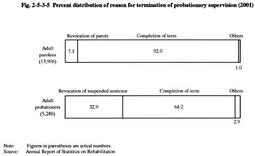| Previous Next Index Image Index Year Selection | |
|
|
4 Results of implementation of probationary supervision (1) State at the time of termination of probationary supervision Fig. 2-5-3-5 shows the percent distribution of parolees and probationers whose probationary supervision terminated in 2001, by reason for termination.
The most common reason for termination of probationary supervision was the expiration of the period of probationary supervision, for 12,789 parolees and 3,392 probationers (including 459 who were granted provisional discharge from probationary supervision). As for the percentages of parolees and probationers whose probationary supervision terminated due to revocation of parole and revocation of suspended sentence in 2001, viewed by type of offense at the time when the parolee or probationer was newly received by probation offices (excluding offenses for which the number of parolees and probationers whose probationary supervision terminated was less than 100), the percentage of those whose probationary supervision terminated due to the former reason was highest for larceny (11.2%), followed by breaking and entering(8.3%), fraud (7.2%), and Stimulant Drug Control Law violation (7.1%), while the percentage of those whose probationary supervision terminated due to the latter reason was highest for fraud (42.7%), followed by larceny (38.0%) and Stimulant Drug Control Law violation (35.9%), in that order in both cases (Source: Annual Report of Statistics on Rehabilitation). Fig. 2-5-3-5 Percent distribution of reason for termination of probationary supervision (2001) (2) State of parolees and probationers who were newly disposed for a repeat offense that they committed during the period of probationary supervision and of those who were reimprisoned In 2001, the percentage of adult parolees and adult probationers whose probationary supervision terminated but were newly sentenced for a repeat offense that they committed during the period of probationary supervision was 0.7% (97 offenders) for adult parolees and 35.5% (1,875 offenders) for adult probationers. By type of offense at the time when the parolee or probationer was newly received by probation offices (excluding offenses for which the number of parolees and probationers whose probationary supervision terminated was less than 100), the percentage was highest for arson (3.3%) in the case of adult parolees, followed by homicide (1.8%), and robbery (1.8%) in that order, while it was highest for fraud (43.9%) in the case of adult probationers, followed by extortion (41.0%), larceny (41.0%) and Stimulant Drug Control Law violation (37.8%) in that order (Source: Annual Report of Statistics on Rehabilitation).
As shown in Table 2-4-2-8 , with respect to the aggregate percentages of inmates released on parole and inmates released on completion of their sentence who were reimprisoned to penal institutions within 5 years from the year of release (aggregate reimprisonment rate), the percentage has been consistently lower for parolees than that for inmates released on completion of their sentence. |
